Most of Canada is locked in winter’s icy grasp in early March, but not the BC south coast. Here’s the story of how four of us beat cabin fever with a weekend hiking trip to Juan de Fuca Provincial Park on Vancouver Island—on the first weekend in March.
Spoiler alert: it was harder than we expected.
Planning the trip
Details are slight when it comes to planning a hiking trip to Juan de Fuca Park in March. While the park is open year-round, it doesn’t seem as though many people trek the Marine Trail during the winter.
And yet, it seemed so possible!
After a long winter of not really going anywhere or doing anything, we wanted to get out camping and hiking again as early as possible in 2022. But we’re not snow camping people, so options are limited even during the mild winters of the Vancouver area. Those mountains are great if you like skiing, less so if you want to go hiking in March.
Enter the Juan de Fuca Marine Trail: a 47-kilometre trek along the southwest coast of Vancouver Island—no mountains to speak of. Having checked the average weather for the area, it seemed plausible that there could be an opportunity to visit in March (and not get soaked or frozen).
The plan was to wait and see if any weather forecasts would foretell a decent weekend in March; we’d then make a last-minute decision to go. We didn’t think it’d work, given that typical March weather is cold and rainy.
But we were wrong.
Travelling to Juan de Fuca Provincial Park
We left the Lower Mainland Friday after work, not wanting to book days off for a trip that was always intended to happen on short notice. Of course, that meant arriving on the Island’s west coast pretty late—like after 10:00 pm.
Missing the 5:00 ferry to Swartz Bay but making it onto the 6:00, we drove as far as French Beach Provincial Park. It was dark, so we had no idea what anything actually looked like, but there was an open spot and we took it.
We walked over to the beach before going to sleep. It was probably beautiful, but I couldn’t really say (because of the darkness).
The next morning, we were greeted by a brisk, cloudless day. We’d seen the weather forecast that promised a sunny weekend, but it was still hard to believe our luck could be so good. We also noted that the campground at French Beach was pretty nice, and probably worth coming back to.
We packed up the tents and drove 36 kilometres further to the Sombrio Beach trailhead.
Sombrio Beach is at roughly the half-way point of the Juan de Fuca Marine Trail, 29 kilometres north from the southernmost trailhead. We had no delusions about hiking the whole trail in a weekend—we just wanted to get out and enjoy the fresh ocean air.
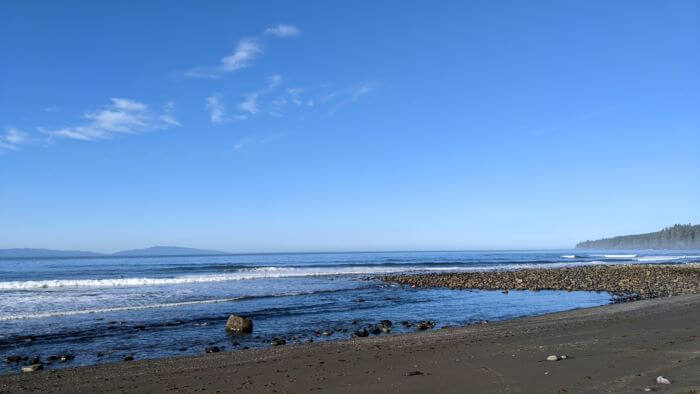
At the time, the trail was actually closed for repairs and upgrades from the southern terminus up to Chin Beach, at the 21-kilometre mark. Chin Beach is not to be confused with China beach, which is also on the trail. Who says you can’t have two beaches with basically the same name right next to each other?
The campsites north of Sombrio Beach are forest campsites, emphatically located not on the beach. We wanted the beach, so that left us one option: hike eight kilometres south to Chin Beach on Saturday, and back on Sunday.
The official Juan de Fuca Marine Trail map from BC Parks breaks the trek into moderate, difficult, and most difficult sections. Since we were hiking for fun, and at least one party member hadn’t backpacked overnight in a while, we wanted to keep things simple. The section from Sombrio to Chin was “difficult,” but not “most difficult.”
How bad could it be?
A most difficult journey
The “most difficult” section of the trail was closed, but I’d have loved to see it; the “difficult” section was no cakewalk.
We set out from the Sombrio parking lot at about 9:30 Saturday morning, surrounded by surfers headed to the beach. It seemed an auspicious start, as the trail down to the beach was basically a gravel highway. That was the first 250 metres—it got worse.
We sauntered along the beach, following the trail south, enjoying the sun and the fresh morning air. But, not long after reaching the beach, the path took the first of several jaunts up into the forest and away from the shore.
That’s when we started to realize we were in for a tougher day than we’d expected.
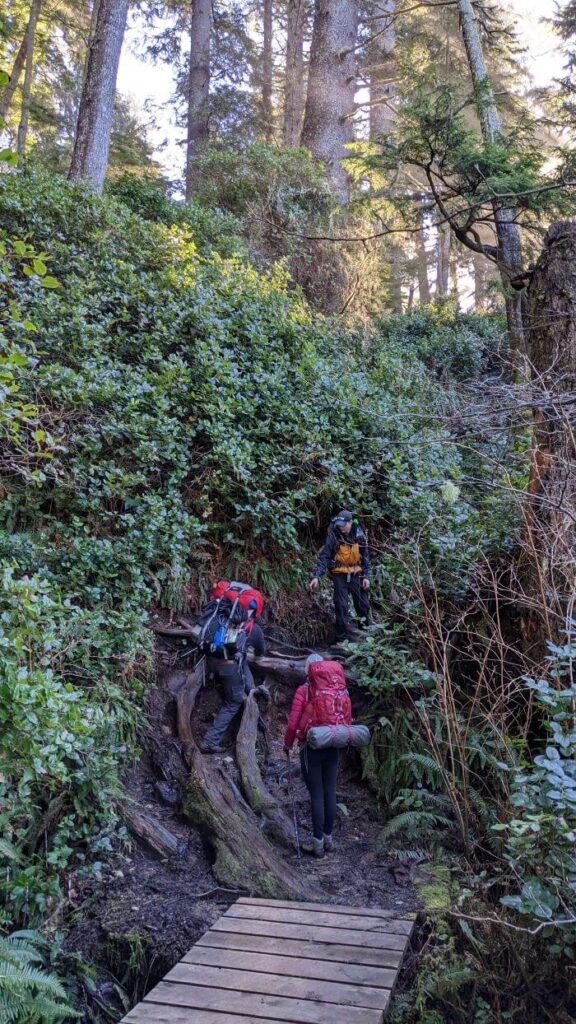
When the trail heads up into the trees, the pebbles and rocks of the beach give way to roots and mud. We knew it would be muddy, and with proper footwear a little mud is no issue. What we didn’t expect was how much up there can be on a trail that never reaches higher than 166 metres above sea level.
The summit of the Marine Trail is not high, but the constant up-and-down adds up to exhausting very quickly. And when the trail does go up, it goes up—many sections turn tree roots into makeshift ladders.
Nevertheless, we kept going. There was a lovely flat section in the middle, but aside from that, most of the journey between Sombrio and Chin beaches was up and down wet rocks and slimy roots.
A notable exception, though, is the Loss Creek Suspension Bridge—a piece of engineering that really stands out amongst the old growth forest.
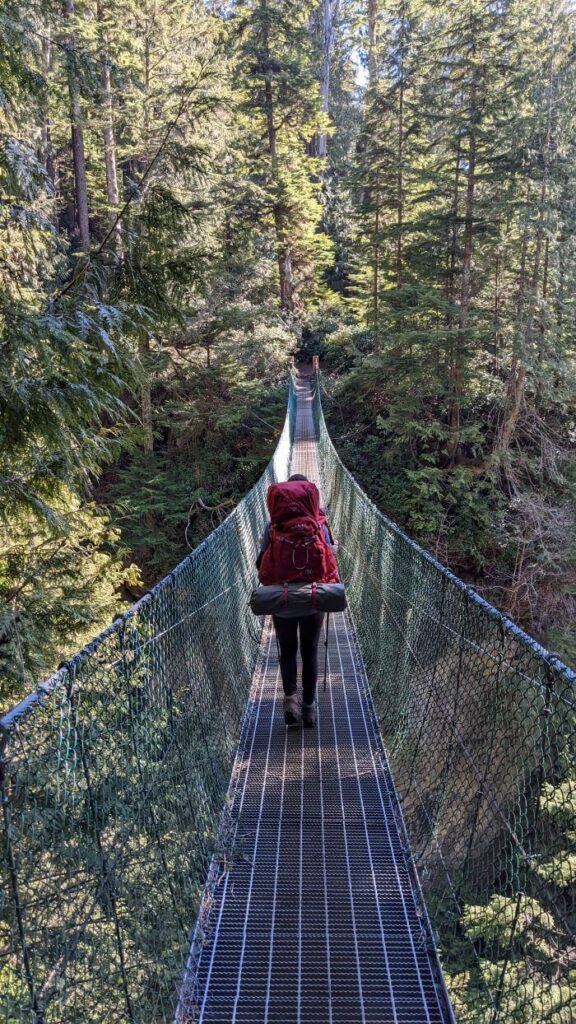
There was a short section just north of the Chin Beach campsite where we had the option of continuing up through the forest, or staying along the beach. Unfortunately, the beach option is only available at low tide, and that’s exactly when we were not there. Alas, more roots and mud and climbing for us.
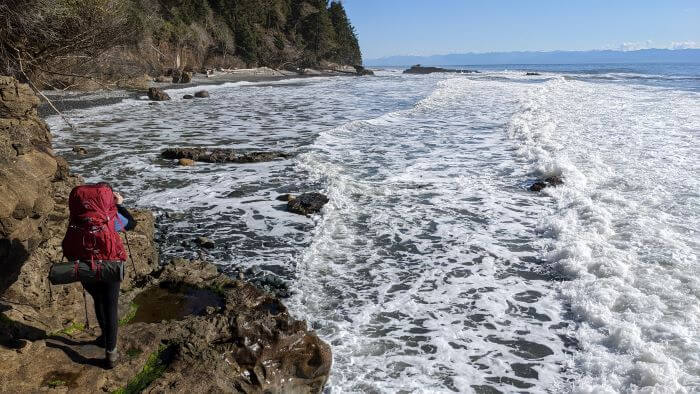
Most folks can travel about 3.2 kilometres per hour on foot, with a heavy pack. That would mean finishing this particular eight-kilometre segment in less than three hours. It took us five.
Chin Beach campground
After a more adventurous day than we’d expected, Chin Beach campground was a delight.
It was, as advertised, right on the beach. There wasn’t much there, really; the bear caches apparently met their end under a massive fallen tree, and the only other structure was the toilet.
Nevertheless, it was a fantastic place to spend the night following a gruelling hike. After setting up our tents in a shaded area under the trees and next to a burbling stream, we still had about 4 hours of daylight to enjoy the spot.
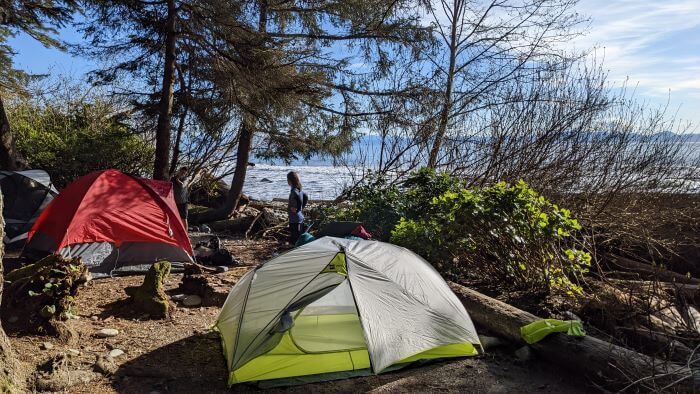
I tried swimming in the ocean, which did not pan out (the ocean is cold in the winter, turns out).
We got a lovely beach fire going, and were able to keep it blazing for the entire evening and night thanks to a hoard of driftwood all along the beachfront. A normal beach fire is one thing; a beach fire in technically-winter after a punishing overland trek is a pleasure all its own.
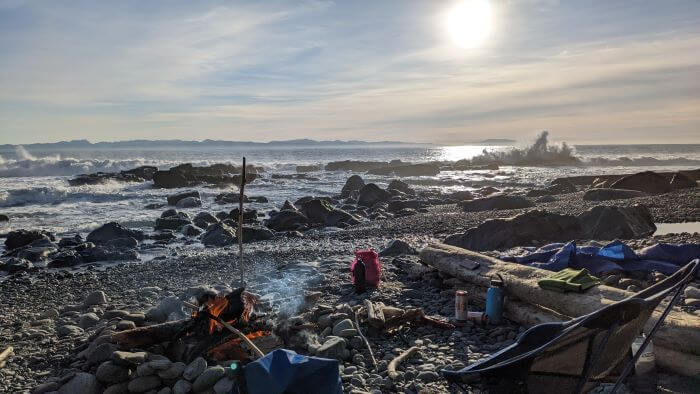
We stayed up hours past sunset (not hard, since that was at about 6:00) and were rewarded with a wide-open sky of stars. Sleeping next to the ocean was excellent. Despite calm air under our forest canopy, the waves were absolutely roaring, and it was a delight.
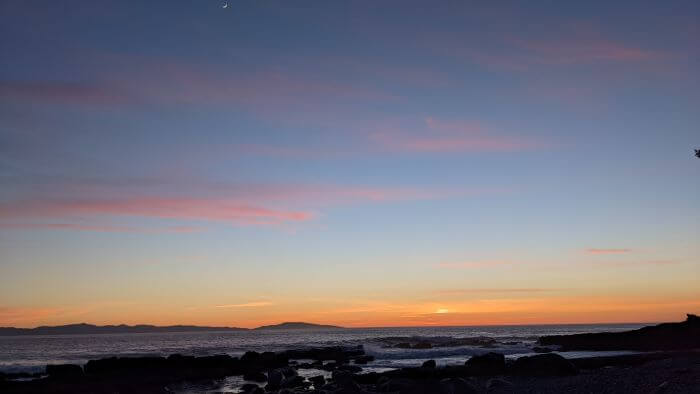
Day 2 – The long trip back
We woke up to another bright blue sky, with the air cold and the sun warm—perfect.
Knowing we had to repeat the previous day’s ordeal, we’d planned to get up and get going as early as possible. Partly to take advantage of low tide shortcuts, and partly to just get it over with.
Setting out across the beach trail that was underwater when we’d passed the day prior, we almost immediately shaved an hour off our expected time. In fact, we made fantastic progress for most of the day. Knowing exactly how much of a challenge you’re in for certainly helps, as does the promise of cheeseburgers once you reach the finish line.
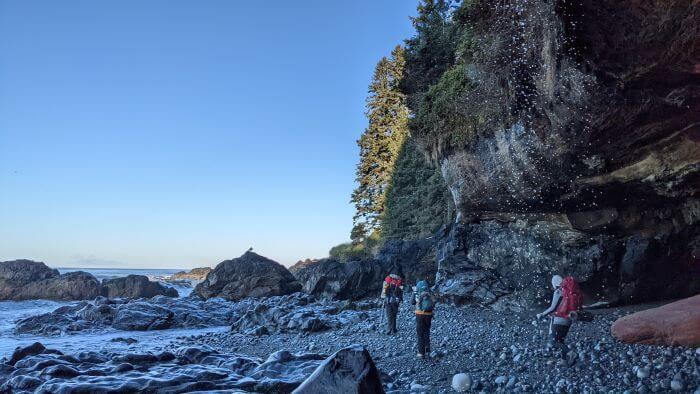
Towards the final third of the trip, though, we became sluggish. Exhausted legs can only move so fast, and the root-ladders were no more forgiving in the opposite direction. Motivating us was the knowledge that the final kilometre would be nice, flat beach walking.
When we finally reached the beach, we were elated—until we started walking on it. Turns out that 1,000 metres of stumbling over stones and gravel with legs like Jell-O is no mean feat. We also forgot that the trail between the beach and the parking lot adds another quarter-kilometre, and uphill at that.
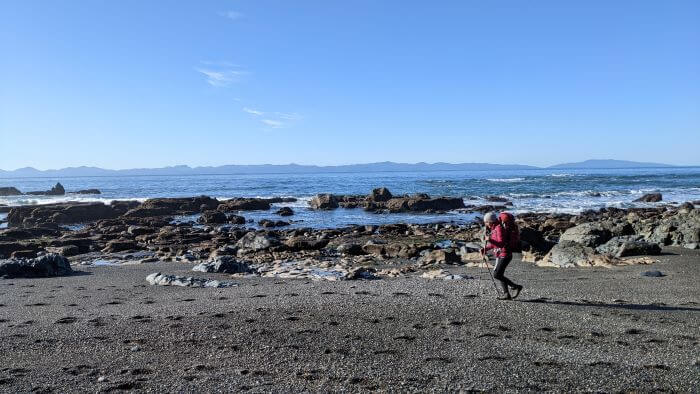
But we did it. We got back to the car in about 3.5 hours. We made a ferry reservation en route to Swartz Bay. Knowing we had some extra time before the crossing, we stopped for lunch and I had the best damn 1:00 pm Egg McMuffin I’ve ever eaten.
Questions or comments? Leave ’em below. Want to read another overnight backpacking story? Check out this story about camping at Joffre Lakes.

